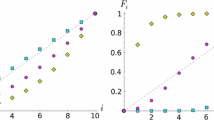Abstract
We introduce a Markov chain model to study evolution of a continuous trait based on population genetics. It corresponds to individual-based model which includes frequency dependent selection caused by m-player game interactions and stochastic fluctuations due to random genetic drift and mutation. We prove that under a proper scaling limit as the population size increases the system converges to the solution of replicator–mutator equations. Our result establishes an affirmative mathematical base to the adaptive dynamics formulation employed in the theory of the mathematical biology.
Similar content being viewed by others
References
Alfaro, M., Carles, R.: Explicit Solutions for Replicator-Mutator Equations: Extinction Versus Acceleration. SIAM J. Appl. Math. 74, 1919–1934 (2014)
Baar, M.,Bovier, A., Champagnat, N.: From Stochastic, Individual-Based Models to the Canonical Equation of Adaptive Dynamics—in one step. arXiv:1505.02421v2 (2015)
Champagnat, N., Ferriere, R., Ben Arous, G.: The Canonical Equation of Adaptive Dynamics: A Mathematical View. Selection 2, 73–83 (2001)
Champagnat, N., Ferriere, R., Méléard, S.: Unifying Evolutionary Dynamics: From Individual Stochastic Processes to Macroscopic Models. Theor. Popul. Biol. 69, 297–321 (2006)
Dieckmann, U., Law, R.: The Dynamical Theory of Coevolution: A Derivation From Stochastic Ecological Processes. J. Math. Biol. 34, 579–612 (1996)
Doebeli, M., Hauert, C., Killingback, T.: The Evolutionary Origin of Cooperators and Defectors. Science 306, 859–862 (2004)
Ethier, S.N., Kurtz, T.G.: The Infinitely-Many-Alleles Model with Selection as a Measure-Valued Diffusion. Stoch. Methods Biol. Lect. Notes Biomath. 70, 72–86 (1987)
Ethier, S.N., Kurtz, T.G.: Markov Processes. Probability and Mathematical Statistics. Wiley, New York, Characterization and Convergence (1986)
Fournier, N., Méléard, S.: A Microscopic Probabilistic Description of a Locally Regulated Population and Macroscopic Approximations. Ann. Appl. Probab. 14, 1880–1919 (2004)
Funaki, T.: A Certain Class of Diffusion Processes Associated with Nonlinear Parabolic Equations. Z. Wahrsch. Verw. Gebiete 67, 331–348 (1984)
Ito, K., Ohtsuki, H., Yamauchi, A.: Relationship Between Aggregation of Rewards and the Possibility of Polymorphism in Continuous Snowdrift Games. J. Theor. Biol. 372, 47–53 (2015)
Parvinen, K., Ohtsuki, H., Wakano, J.Y.: The Effect of Fecundity Derivatives on the Condition of Evolutionary Branching in Spatial Models, J. Theor. Biol. 416, 129–143 (2017)
Sznitman, A.-S.: Topics in Propagation of Chaos, École d’Été de Probabilités de Saint-Flour XIX–1989, Lecture Notes in Math., vol. 1464, pp. 165–251. Springer, Berlin (1991)
Wakano, J.Y., Iwasa, Y.: Evolutionary Branching in a Finite Population: Deterministic Branching vs. Stochastic Branching. Genetics 193, 229–241 (2013)
Wakano, J.Y., Lehmann, L.: Evolutionary Branching in Deme-Structured Populations. J. Theor. Biol. 351, 83–95 (2014)
Acknowledgements
The authors thank Professors Masayasu Mimura, Toshiyuki Ogawa and Kenji Handa for helpful discussions. They also express great thanks to the referee for his/her careful reading and kind comments which improve the paper considerably.
Author information
Authors and Affiliations
Corresponding author
Additional information
Dedicated to Professor Masayasu Mimura on his 75th birthday.
J. Y. Wakano is supported in part by the JSPF KAKENHI Grant Number (C) 16K05283.
T. Funaki is supported in part by the JSPS KAKENHI Grant Numbers (B) 26287014 and 26610019.
S. Yokoyama is supported in part by the JSPS KAKENHI Grant Number (S) 24224004.
About this article
Cite this article
Wakano, J.Y., Funaki, T. & Yokoyama, S. Derivation of replicator–mutator equations from a model in population genetics. Japan J. Indust. Appl. Math. 34, 473–488 (2017). https://doi.org/10.1007/s13160-017-0249-9
Received:
Revised:
Published:
Issue Date:
DOI: https://doi.org/10.1007/s13160-017-0249-9




